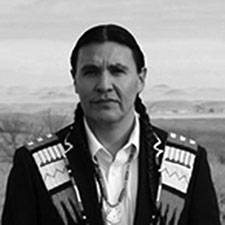January 2015 Story of the Month:
The Courage to Tell Their Stories
In South Dakota, Native American parents broke the silence and demanded change.
BY CHASE IRON EYES and SARA NELSON as told to ANTOINETTE ROBINSON
| |
 |
| Chase Iron Eyes |
In 2005, Native Americans in South Dakota reached out to human rights lawyers because more than 700 Native American children in South Dakota were taken from their families every year. Here, Chase Iron Eyes, South Dakota Counsel for the Lakota People’s Law Project, and Sara Nelson, the Project’s Executive Director, describe how people came together to bring about change:
Q: What led the Native American community to organize to reform child welfare?
Iron Eyes: Life on the reservation is defined by extremes. On the one side, we have beautiful ceremonial aspects to our lives, including respect for the land and a relationship with sacred sites. One the other side, we’re impacted by poverty and substance abuse and a lack of hope.
The destruction of our economic way of life and the boarding school era, when thousands of Native Americans were stolen from their families and sent to White-run boarding schools, had a deep impact on our community. My grandparents went to those boarding schools. My own mother went to one of those schools. Their intent was to break the family unit and destroy our culture.
I grew up with the effects of that. I never had a dad. My mother had a substance abuse problem until I was in 10th grade, when Lakota religious traditions helped her find stability and healing. When you’re torn from your family and from your past, it makes you feel like an orphan in the universe, but my mother found a way to rebuild her foundation. I spent a lot of my time with my grandmother, who also had a substance abuse problem. We would drift around with a bunch of elders who had all been to the boarding schools, who were broken and had never healed.
Hundreds of Native American children go into foster care every year in South Dakota. In 2005, some grandmothers got together to try to change the situation. They didn’t have money and they didn’t know how to fight the system, but they got Danny Sheehan, the public interest attorney of the Romero Institute to meet with them. He kept hearing the same stories over and over about children being taken without proper investigations and grandmothers and aunties being overlooked as placements for their kin.
Nelson: Danny is a lawyer with many years of interviewing witnesses and he found the stories of the parents and grandparents he interviewed very credible. But when he talked to government officials, he found them unwilling to listen to the concerns of the community.
Iron Eyes: In fact, the American Civil Liberties Union recently brought a lawsuit against the state on behalf of the tribes. They read transcripts of the hearings that happen 48 hours after a child is taken into custody to determine whether a child goes home or remains in care. What they discovered was that the hearings lasted only 4 minutes, on average, and more than 90% of children remaining in care. Sometimes parents weren’t given a chance to speak or even told about the hearings. Then, more than 90% of Native American children were placed with non-Native families.
Q: How did the Lakota People’s Law Project get started?
Nelson: In 2006, we opened a small office and hired Lakota staff as soon as we could. They began going to different reservations and having meetings with parents. There was a lot of fear—a lot. But plenty of parents and grandparents had the courage to come forward to tell their stories.
In 2011, two big things happened. First, there was a lot of public attention in South Dakota to a case of a couple that had adopted Native American children out of the foster care system and abused them. When the children had asked the child welfare system for help, officials insisted they were lying. Then National Public Radio ran a series on the child welfare system’s treatment of Native Americans in South Dakota. Members of the United States Congress began asking for a hearing to investigate what was going on in South Dakota.
Iron Eyes: When the Lakota People’s Law Project approached me in 2011, I was the attorney for my reservation. One night I sat down and read their report. It felt just like a continuation of the boarding school era. I got livid. I had concerns that I might get in trouble if I became an activist. But I knew that it was the righteous thing to do. I began taking a leadership role in trying to bring child welfare money to the tribes to try to run our own child welfare systems.
Q: What are the next steps?
Nelson: In 2012 we made the decision to shift our focus from bringing a lawsuit to developing a policy solution. Eight of the nine reservations in South Dakota applied to receive a grant from the federal government to plan and prepare to run their own child welfare systems. One tribe has already received it. If they are approved, the tribes can recruit foster parents, improve their court system and build their capacity to strengthen parenting and heal trauma rather than create new trauma.
We have seen that pressure can change the system. Child welfare officials in South Dakota are now beginning to contact tribal officials about making more money available for kinship care and about placing children with foster families on the reservation. That never would have happened a couple of years ago.























